Abstract
The human A3 adenosine receptor was cloned from a striatal cDNA library using a probe derived from the homologous rat sequence. The cDNA encodes a protein of 318 amino acids and exhibits 72% and 85% overall identity with the rat and sheep A3 adenosine receptor sequences, respectively. Specific and saturable binding of the adenosine receptor agonist N6-(4-amino-3-[125I]iodobenzyl)adenosine [125I]ABA was measured on the human A3 receptor stably expressed in Chinese hamster ovary cells with a Kd = 10 nM. The potency order for adenosine receptor agonists was N-ethylcarboxamidoadenosine (NECA) > or = (R)-N6-phenyl-2-propyladenosine [(R)-PIA] > N6-cyclopentyladenosine (CPA) > (S)-N6-phenyl-2-propyladenosine [(S)-PIA]. The human receptor was blocked by xanthine antagonists, most potently by 3-(3-iodo-4-aminobenzyl)-8-(4-oxyacetate)phenyl-1-propylxanthine (I-ABOPX) with a potency order of I-ABOPX > 1,3-dipropyl-8-(4-acrylate)phenylxanthine > or = xanthine amino congener >> 1,3-dipropyl-8-cyclopentylxanthine. Adenosine, NECA, (R)- and (S)-PIA, and CPA inhibited forskolin-stimulated cAMP accumulation by 30-40% in stably transfected cells; I-ABA is a partial agonist. When measured in the presence of antagonists, the dose-response curves of NECA-induced inhibition of forskolin-stimulated cAMP accumulation were right-shifted. Antagonist potencies determined by Schild analyses correlated well with those established by competition for radioligand binding. The A3 adenosine receptor transcript is widespread and, in contrast to the A1, A2a, and A2b transcripts, the most abundant expression is found in the lung and liver. The tissue distribution of A3 mRNA is more similar to the widespread profile found in sheep than to the restricted profile found in the rat. This raises the possibility that numerous physiological effects of adenosine may be mediated by A3 adenosine receptors.
Full text
PDF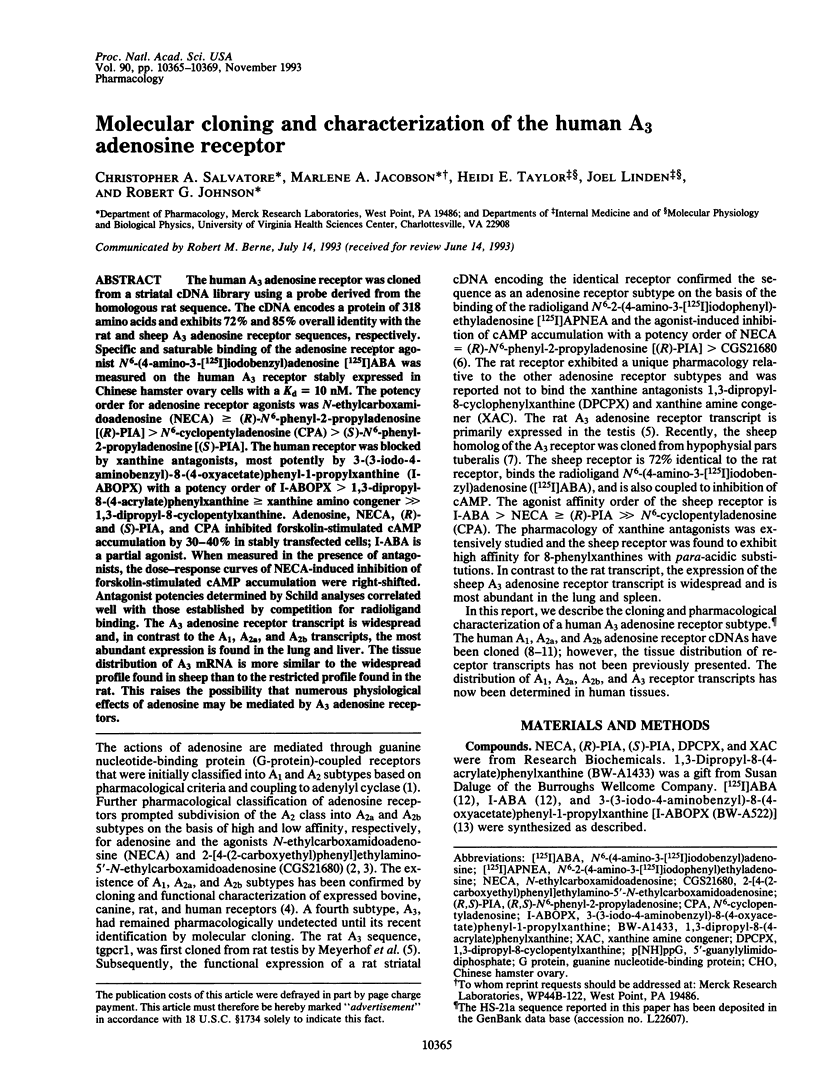
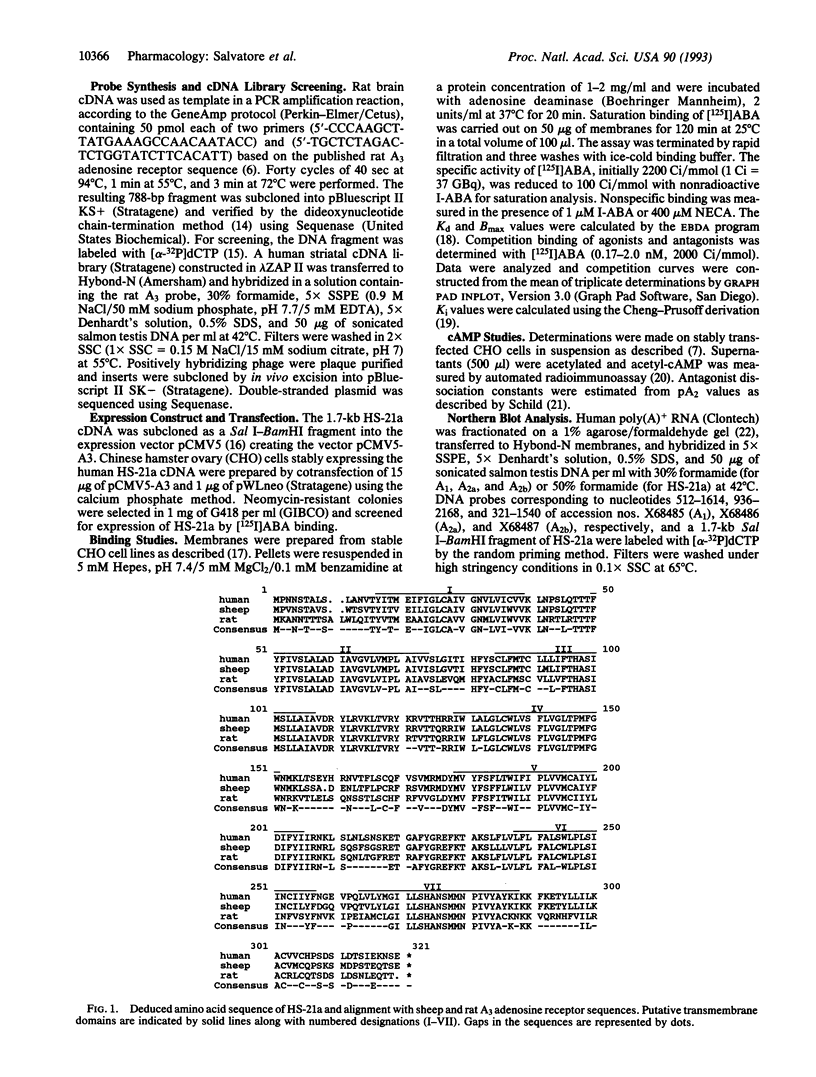
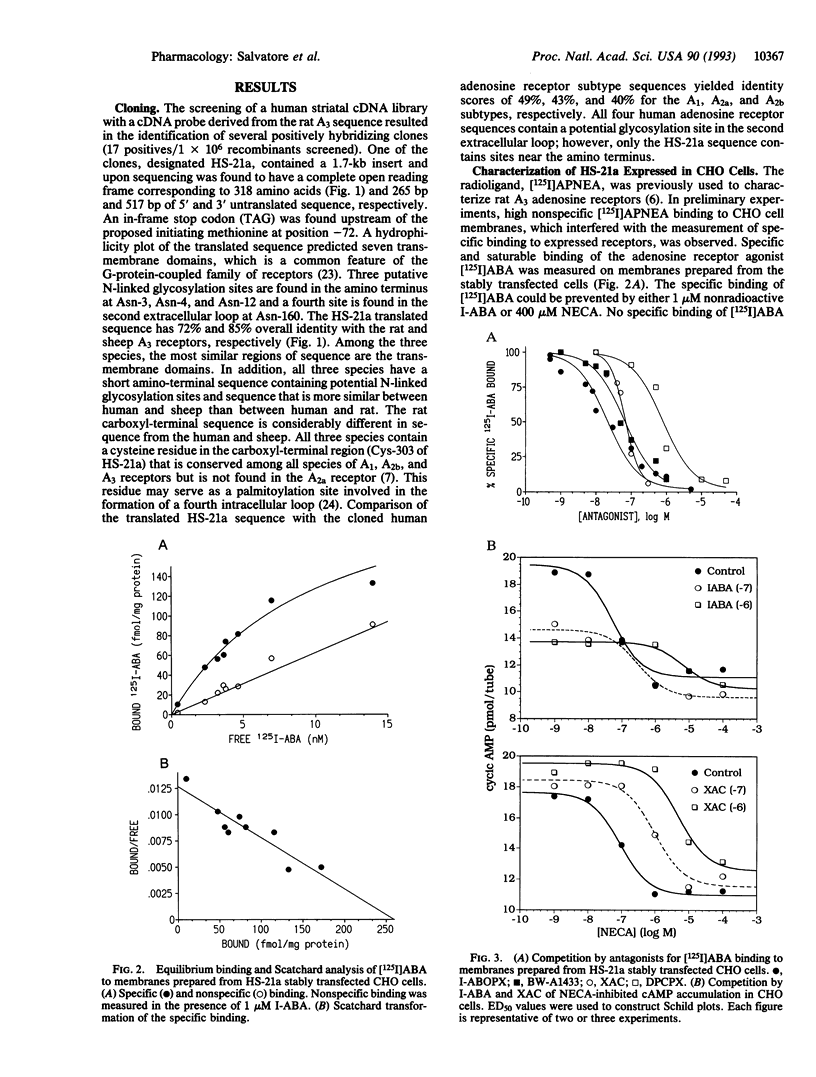
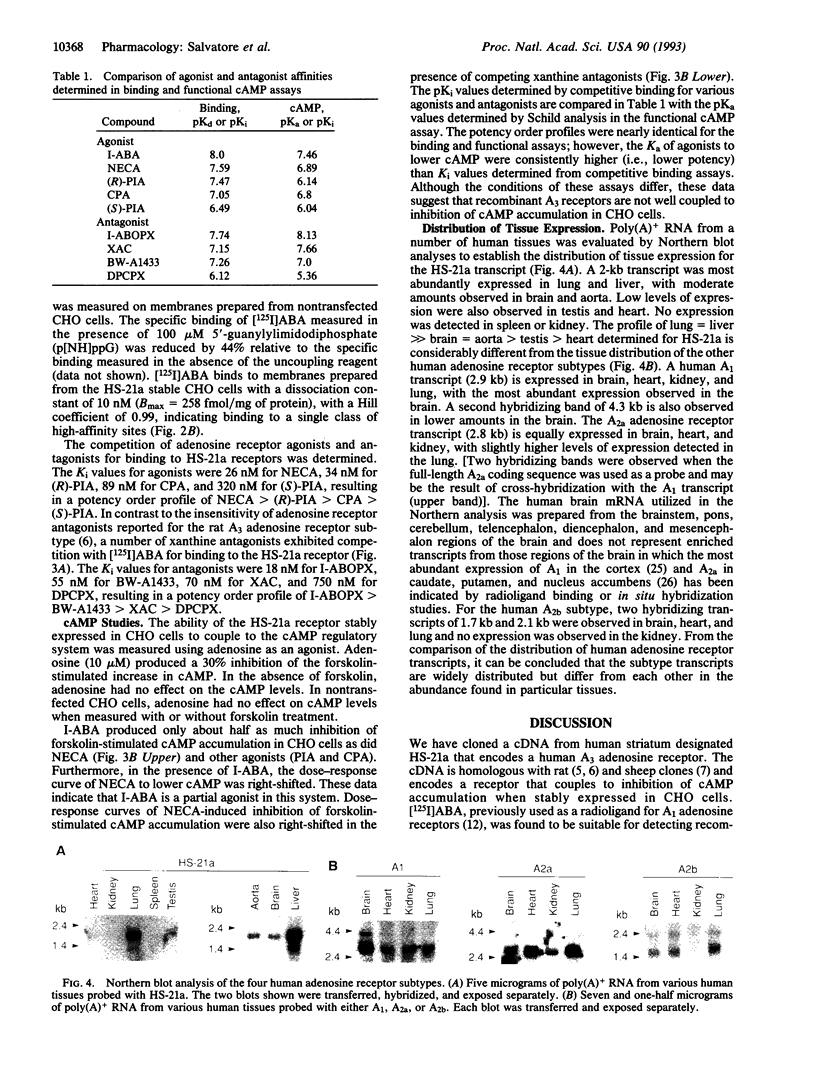
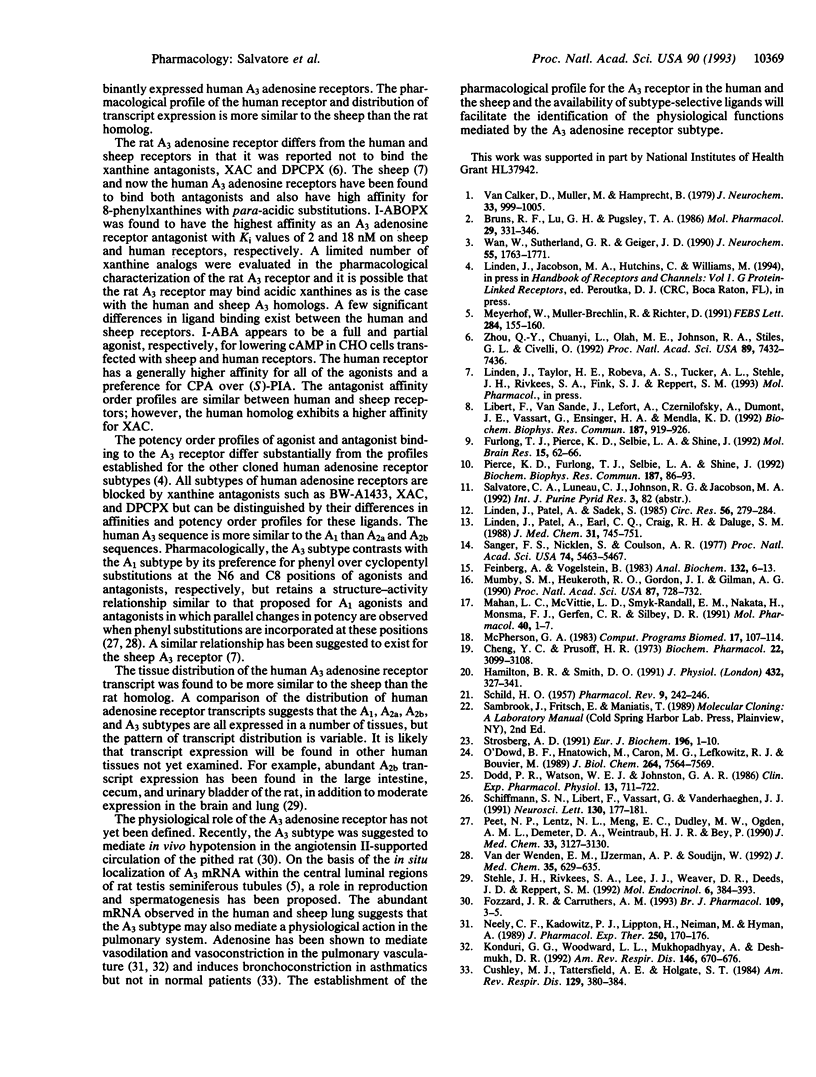
Images in this article
Selected References
These references are in PubMed. This may not be the complete list of references from this article.
- Bruns R. F., Lu G. H., Pugsley T. A. Characterization of the A2 adenosine receptor labeled by [3H]NECA in rat striatal membranes. Mol Pharmacol. 1986 Apr;29(4):331–346. [PubMed] [Google Scholar]
- Cheng Y., Prusoff W. H. Relationship between the inhibition constant (K1) and the concentration of inhibitor which causes 50 per cent inhibition (I50) of an enzymatic reaction. Biochem Pharmacol. 1973 Dec 1;22(23):3099–3108. doi: 10.1016/0006-2952(73)90196-2. [DOI] [PubMed] [Google Scholar]
- Cushley M. J., Tattersfield A. E., Holgate S. T. Adenosine-induced bronchoconstriction in asthma. Antagonism by inhaled theophylline. Am Rev Respir Dis. 1984 Mar;129(3):380–384. doi: 10.1164/arrd.1984.129.3.380. [DOI] [PubMed] [Google Scholar]
- Dodd P. R., Watson W. E., Johnston G. A. Adenosine receptors in post-mortem human cerebral cortex and the effect of carbamazepine. Clin Exp Pharmacol Physiol. 1986 Oct;13(10):711–722. doi: 10.1111/j.1440-1681.1986.tb02412.x. [DOI] [PubMed] [Google Scholar]
- Feinberg A. P., Vogelstein B. A technique for radiolabeling DNA restriction endonuclease fragments to high specific activity. Anal Biochem. 1983 Jul 1;132(1):6–13. doi: 10.1016/0003-2697(83)90418-9. [DOI] [PubMed] [Google Scholar]
- Fozard J. R., Carruthers A. M. Adenosine A3 receptors mediate hypotension in the angiotensin II-supported circulation of the pithed rat. Br J Pharmacol. 1993 May;109(1):3–5. doi: 10.1111/j.1476-5381.1993.tb13522.x. [DOI] [PMC free article] [PubMed] [Google Scholar]
- Furlong T. J., Pierce K. D., Selbie L. A., Shine J. Molecular characterization of a human brain adenosine A2 receptor. Brain Res Mol Brain Res. 1992 Sep;15(1-2):62–66. doi: 10.1016/0169-328x(92)90152-2. [DOI] [PubMed] [Google Scholar]
- Hamilton B. R., Smith D. O. Autoreceptor-mediated purinergic and cholinergic inhibition of motor nerve terminal calcium currents in the rat. J Physiol. 1991 Jan;432:327–341. doi: 10.1113/jphysiol.1991.sp018387. [DOI] [PMC free article] [PubMed] [Google Scholar]
- Konduri G. G., Woodard L. L., Mukhopadhyay A., Deshmukh D. R. Adenosine is a pulmonary vasodilator in newborn lambs. Am Rev Respir Dis. 1992 Sep;146(3):670–676. doi: 10.1164/ajrccm/146.3.670. [DOI] [PubMed] [Google Scholar]
- Libert F., Van Sande J., Lefort A., Czernilofsky A., Dumont J. E., Vassart G., Ensinger H. A., Mendla K. D. Cloning and functional characterization of a human A1 adenosine receptor. Biochem Biophys Res Commun. 1992 Sep 16;187(2):919–926. doi: 10.1016/0006-291x(92)91285-x. [DOI] [PubMed] [Google Scholar]
- Linden J., Patel A., Earl C. Q., Craig R. H., Daluge S. M. 125I-labeled 8-phenylxanthine derivatives: antagonist radioligands for adenosine A1 receptors. J Med Chem. 1988 Apr;31(4):745–751. doi: 10.1021/jm00399a010. [DOI] [PubMed] [Google Scholar]
- Linden J., Patel A., Sadek S. [125I]Aminobenzyladenosine, a new radioligand with improved specific binding to adenosine receptors in heart. Circ Res. 1985 Feb;56(2):279–284. doi: 10.1161/01.res.56.2.279. [DOI] [PubMed] [Google Scholar]
- Mahan L. C., McVittie L. D., Smyk-Randall E. M., Nakata H., Monsma F. J., Jr, Gerfen C. R., Sibley D. R. Cloning and expression of an A1 adenosine receptor from rat brain. Mol Pharmacol. 1991 Jul;40(1):1–7. [PubMed] [Google Scholar]
- McPherson G. A. A practical computer-based approach to the analysis of radioligand binding experiments. Comput Programs Biomed. 1983 Aug-Oct;17(1-2):107–113. doi: 10.1016/0010-468x(83)90031-4. [DOI] [PubMed] [Google Scholar]
- Meyerhof W., Müller-Brechlin R., Richter D. Molecular cloning of a novel putative G-protein coupled receptor expressed during rat spermiogenesis. FEBS Lett. 1991 Jun 24;284(2):155–160. doi: 10.1016/0014-5793(91)80674-r. [DOI] [PubMed] [Google Scholar]
- Mumby S. M., Heukeroth R. O., Gordon J. I., Gilman A. G. G-protein alpha-subunit expression, myristoylation, and membrane association in COS cells. Proc Natl Acad Sci U S A. 1990 Jan;87(2):728–732. doi: 10.1073/pnas.87.2.728. [DOI] [PMC free article] [PubMed] [Google Scholar]
- Neely C. F., Kadowitz P. J., Lippton H., Neiman M., Hyman A. L. Adenosine does not mediate the pulmonary vasodilator response of adenosine 5'-triphosphate in the feline pulmonary vascular bed. J Pharmacol Exp Ther. 1989 Jul;250(1):170–176. [PubMed] [Google Scholar]
- O'Dowd B. F., Hnatowich M., Caron M. G., Lefkowitz R. J., Bouvier M. Palmitoylation of the human beta 2-adrenergic receptor. Mutation of Cys341 in the carboxyl tail leads to an uncoupled nonpalmitoylated form of the receptor. J Biol Chem. 1989 May 5;264(13):7564–7569. [PubMed] [Google Scholar]
- Peet N. P., Lentz N. L., Meng E. C., Dudley M. W., Ogden A. M., Demeter D. A., Weintraub H. J., Bey P. A novel synthesis of xanthines: support for a new binding mode for xanthines with respect to adenosine at adenosine receptors. J Med Chem. 1990 Dec;33(12):3127–3130. doi: 10.1021/jm00174a004. [DOI] [PubMed] [Google Scholar]
- Pierce K. D., Furlong T. J., Selbie L. A., Shine J. Molecular cloning and expression of an adenosine A2b receptor from human brain. Biochem Biophys Res Commun. 1992 Aug 31;187(1):86–93. doi: 10.1016/s0006-291x(05)81462-7. [DOI] [PubMed] [Google Scholar]
- SCHILD H. O. Drug antagonism and pAx. Pharmacol Rev. 1957 Jun;9(2):242–246. [PubMed] [Google Scholar]
- Sanger F., Nicklen S., Coulson A. R. DNA sequencing with chain-terminating inhibitors. Proc Natl Acad Sci U S A. 1977 Dec;74(12):5463–5467. doi: 10.1073/pnas.74.12.5463. [DOI] [PMC free article] [PubMed] [Google Scholar]
- Schiffmann S. N., Libert F., Vassart G., Vanderhaeghen J. J. Distribution of adenosine A2 receptor mRNA in the human brain. Neurosci Lett. 1991 Sep 16;130(2):177–181. doi: 10.1016/0304-3940(91)90391-6. [DOI] [PubMed] [Google Scholar]
- Stehle J. H., Rivkees S. A., Lee J. J., Weaver D. R., Deeds J. D., Reppert S. M. Molecular cloning and expression of the cDNA for a novel A2-adenosine receptor subtype. Mol Endocrinol. 1992 Mar;6(3):384–393. doi: 10.1210/mend.6.3.1584214. [DOI] [PubMed] [Google Scholar]
- Strosberg A. D. Structure/function relationship of proteins belonging to the family of receptors coupled to GTP-binding proteins. Eur J Biochem. 1991 Feb 26;196(1):1–10. doi: 10.1111/j.1432-1033.1991.tb15778.x. [DOI] [PubMed] [Google Scholar]
- Wan W., Sutherland G. R., Geiger J. D. Binding of the adenosine A2 receptor ligand [3H]CGS 21680 to human and rat brain: evidence for multiple affinity sites. J Neurochem. 1990 Nov;55(5):1763–1771. doi: 10.1111/j.1471-4159.1990.tb04967.x. [DOI] [PubMed] [Google Scholar]
- Zhou Q. Y., Li C., Olah M. E., Johnson R. A., Stiles G. L., Civelli O. Molecular cloning and characterization of an adenosine receptor: the A3 adenosine receptor. Proc Natl Acad Sci U S A. 1992 Aug 15;89(16):7432–7436. doi: 10.1073/pnas.89.16.7432. [DOI] [PMC free article] [PubMed] [Google Scholar]
- van Calker D., Müller M., Hamprecht B. Adenosine regulates via two different types of receptors, the accumulation of cyclic AMP in cultured brain cells. J Neurochem. 1979 Nov;33(5):999–1005. doi: 10.1111/j.1471-4159.1979.tb05236.x. [DOI] [PubMed] [Google Scholar]
- van der Wenden E. M., Ijzerman A. P., Soudijn W. A steric and electrostatic comparison of three models for the agonist/antagonist binding site on the adenosine A1 receptor. J Med Chem. 1992 Feb 21;35(4):629–635. doi: 10.1021/jm00082a003. [DOI] [PubMed] [Google Scholar]



